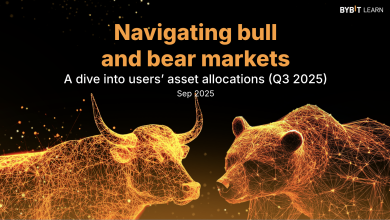The Future of Crypto Investing: Strategies for the Next Market Cycle


KEY TAKEAWAYS
- The next crypto cycle may be fueled by institutional adoption, regulation, and broader real-world use cases.
- Diversification across blue-chip assets, altcoins, stablecoins, and tokenized RWAs balances growth and risk.
- Institutional-grade risk management tools like VaR, stress testing, and correlation analysis enhance portfolio resilience.
- Dollar-cost averaging and long-term holding strategies assist investors manage volatility effectively.
- Growth sectors for investors to note include DeFi, AI tokens, interoperability projects, and tokenized real-world assets.
- Regulation and macroeconomic conditions remain key drivers for future crypto investment strategies.
The cryptocurrency market is rapidly evolving, marked by past cycles of dramatic price surges and corrections. As investors and institutions gear up for the next market cycle anticipated in 2025 and beyond, developing effective crypto investing strategies rooted in the latest trends, regulatory environment, and market dynamics becomes paramount.
This article explores the future of crypto investing, outlining key strategies designed to navigate the upcoming market cycle with insight and prudence.
Evolving Market Landscape and Outlook for the Next Cycle
The crypto market is expected to undergo significant maturation in the near future. Analysts forecast a potential bull run fueled by increased institutional adoption, regulatory clarity, and expanding real-world use cases. On-chain data signals growth in wallet numbers and transaction volumes, indicating broader market engagement.
Major enterprises are increasingly integrating cryptocurrencies into their financial systems, while institutional interest continues to rise, with more professional investors allocating larger portfolio percentages toward digital assets.
Economic factors such as inflation and monetary policies also play an influential role, positioning cryptocurrencies as attractive hedges against currency devaluation. Regulatory initiatives like Europe’s MiCA framework and progressive stances in Asia and the Middle East are fostering a more standardized and secure environment for crypto investments.
These developments collectively set a robust foundation for the next market cycle, promising renewed opportunities for investors prepared with sound strategies.
Core Strategies for Future Crypto Investing
Here are some key approaches to consider:
1. Diversification Across Asset Classes
Building a remains a fundamental principle. Allocating holdings across blue-chip cryptocurrencies like BTC and ETH alongside promising altcoins allows investors to balance stability with growth potential.
Blue-chip tokens constitute the core portfolio, offering liquidity, market depth, and relative resilience. Meanwhile, altcoins, DeFi tokens, and emerging sectors such as real-world assets (RWAs) and interoperability projects serve as satellite investments targeting higher returns.
Including and tokenized yield-bearing assets is also advisable. Stablecoins offer exposure to the crypto economy with lower volatility and provide liquidity for tactical moves during market drawdowns. Meanwhile, tokenized government bonds and short-term treasuries on blockchains are emerging as innovative ways to earn passive income and reduce risk in crypto portfolios.
2. Emphasis on Institutional-Grade Risk Management
As crypto markets mature, institutions are applying sophisticated risk analytics traditionally used in conventional finance. Techniques such as Value-at-Risk (VaR), volatility analysis, and stress testing assist manage downside risk and maintain portfolio resilience amid market shocks.
Volatility-targeted rebalancing involves dynamically adjusting positions aligned to market fluctuations, for example, reducing altcoin exposure during high volatility phases or increasing stablecoin holdings under stress.
Institutions also leverage correlation matrices to identify uncorrelated crypto assets, enhancing true diversification and minimizing redundant exposures. Regular portfolio reviews based on quantitative risk models support informed decision-making, reducing emotional reactions common in retail investing.
3. Incorporating Dollar-Cost Averaging and Long-Term Holding
Given crypto’s notorious volatility, dollar-cost averaging (DCA), investing a fixed sum regularly regardless of price, remains a prudent approach to smooth entry points and mitigate timing risk. Long-term holding or “” core assets like BTC and ETH through market cycles also aligns with the broader narrative of these tokens as digital gold and foundational blockchain protocols.
Strategic patience allows investors to ride out short-term market fluctuations while benefiting from the crypto sector’s long-term growth prospects rooted in adoption, technological advancement, and network effects.
4. Focus on Growth Sectors and Narrative Investing
Innovation drives value in the crypto ecosystem. Focusing on high-growth sectors such as Decentralized Finance (DeFi), Artificial Intelligence (AI)-related tokens, Web3 infrastructure, and real-world asset tokenization can position investors to capitalize on emerging trends. Narrative investing involves identifying stories and technological shifts gaining momentum, which can generate ahead alpha.
Continuous research and staying informed about protocol upgrades, regulatory developments, and partnership announcements provide an edge in spotting tokens with transformative potential before they become mainstream.
5. Leveraging Data-Driven Insights and AI Tools
Advancements in data analytics and artificial intelligence are revolutionizing crypto investing. Platforms offering AI-based token ratings, on-chain metrics analysis, sentiment tracking, and portfolio optimization assist investors in making informed decisions. These tools aggregate and analyze vast datasets while covering fundamentals, market sentiment, and technical indicators to identify undervalued tokens and optimize entry and exit points.
Using AI-driven insights complements fundamental and technical analysis, reducing emotional bias while enhancing portfolio performance in volatile markets.
6. Staying Adaptive to Regulatory and Macro Developments
Regulation will remain a key driver shaping crypto’s future. Favorable regulatory frameworks instill market confidence and encourage institutional participation, while unclear or hostile policies can generate uncertainty. Investors should stay abreast of global regulatory trends, newly approved products like , tax laws, and compliance requirements.
Macro conditions such as interest rate changes, inflation trends, and geopolitical events also influence capital flows into crypto. Effective investors integrate these broader factors into their strategy, aligning exposure according to evolving economic environments.
Emerging Trends Impacting Future Crypto Investing
Several macro trends are poised to influence how crypto investing unfolds in the next market cycle:
- Institutional Expansion: Increasing allocations by hedge funds, pension funds, and corporate treasuries are adding sophistication and liquidity, driving market maturity.
- DeFi and Layer-2 answers: Scaling technology and decentralized protocols continue to advance, unlocking new use cases and improving transaction efficiency.
- Sustainability and Energy Efficiency: Greater emphasis on eco-friendly mining and proof-of-stake consensus mechanisms reflects growing investor preferences for sustainability.
- Emergence of : Digitization of equities, bonds, commodities, and real estate on blockchains broadens investment opportunities beyond traditional cryptocurrencies.
- Interoperability Protocols: Cross-chain answers will reduce fragmentation and improve liquidity across diverse blockchain networks.
Positioning for the Next Crypto Cycle: Strategy, Innovation, and Resilience
The future of crypto investing in the next market cycle demands a judicious blend of strategy, innovation, and risk management. Investors who build diversified portfolios anchored in while selectively exposing themselves to high-growth sectors and emerging narratives are positioned to capitalize on crypto’s evolving opportunity set.
Employing institutional-grade risk controls, leveraging AI-powered data analytics, and maintaining a long-term perspective will assist navigate the inherent volatility and capitalize on structural growth drivers. Staying informed on regulatory and macroeconomic shifts enables timely strategy adjustments and mitigates unforeviewn risks.
In an era where crypto markets are transitioning from speculative frenzy toward mainstream financial integration, adopting well-rounded and adaptive investment strategies is essential. This approach empowers investors to harness the potential of the next crypto market cycle with confidence and resilience.
FAQ
What factors could drive the next crypto bull run?
Institutional adoption, regulatory clarity, real-world use cases, and favorable macroeconomic conditions are expected to fuel the next cycle.
Why is diversification significant in crypto investing?
Diversifying across BTC, ETH, altcoins, stablecoins, and tokenized assets balances risk and positions investors for both stability and growth.
How can institutions improve risk management in crypto?
They apply methods like Value-at-Risk, stress testing, and correlation analysis to manage volatility and ensure portfolio resilience.
What role does dollar-cost averaging (DCA) play?
DCA reduces timing risk by investing consistently over time, while long-term holding of blue-chip tokens captures broader adoption-driven gains.
Which crypto sectors show strong growth potential?
DeFi, Web3 infrastructure, real-world asset tokenization, AI-related tokens, and interoperability protocols are high-growth areas to watch.
How are AI tools changing crypto investing?
AI-powered platforms provide on-chain analysis, sentiment tracking, and portfolio optimization to identify undervalued assets and enhance decision-making.
Why should investors follow regulatory developments?
Regulatory frameworks shape market confidence, institutional participation, and taxation rules, all of which impact investment outcomes.
What macroeconomic factors affect crypto investments?
Factors like Inflation, interest rates, and geopolitical events influence capital flows into digital assets and should be integrated into strategy planning.







